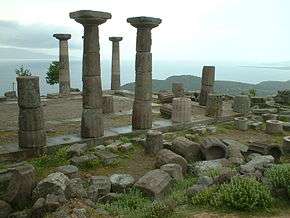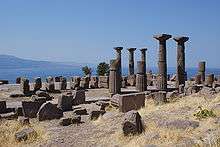Assos
|
Ἄσσος Behramkale | |
 Ruins of the Temple of Athena in Assos | |
 Shown within Turkey | |
| Location | Ayvacık, Çanakkale Province, Turkey |
|---|---|
| Region | Troad |
| Coordinates | 39°29′16″N 26°20′13″E / 39.48778°N 26.33694°ECoordinates: 39°29′16″N 26°20′13″E / 39.48778°N 26.33694°E |
| Type | Settlement |
| History | |
| Builder | Colonists from Mithymna |
| Founded | 10th century BC |
| Associated with | Aristotle |
| Site notes | |
| Website | Assos Archaeological Site |
Assos (/ˈæsɒs/; Greek: Ἄσσος), also known as Behramkale or for short Behram, is a small historically rich town in the Ayvacık district of the Çanakkale Province, Turkey.
After leaving the Platonic Academy in Athens, Aristotle (joined by Xenocrates) went to Assos, where he was welcomed by King Hermias, and opened an Academy in this city.[1] Aristotle also married Pythias, the adopted daughter of Hermias.[1] In the Academy of Assos, Aristotle became a chief to a group of philosophers, and together with them, he made innovative observations on zoology and biology.[1] When the Persians attacked Assos, King Hermias was caught and put to death.[1] Aristotle fled to Macedonia, which was ruled by his friend King Philip II of Macedon.[1] There, he tutored Philip's son, Alexander the Great.[1] There is a modern statue of Aristotle at the town entrance.[2]
The Acts of the Apostles refers to visits by Luke the Evangelist and Paul the Apostle to Assos (Acts 20:13-14) .[3]
Today, Assos is an Aegean-coast seaside retreat amid ancient ruins.
Geography
Though the town is officially named Behramkale (pronounced [behˈramkale]), most people still call it by its ancient name of Assos. The town is on the southern side of Biga Peninsula, better known by its ancient name, Troad. Assos is located on the coast of the Adramyttian Gulf (Turkish: Edremit Körfezi).[4]
Much of the surrounding area is visible from the ancient Temple of Athena, built on top of a trachyte crag. The view from this temple on a clear day extends to nearby Lesbos in the south, Pergamum in the southeast, and Mount Ida in Phrygia in the east. To the north, the Tuzla River flows. To the northwest, two massive Hellenic columns still mark the gate to the city.[4]
Assos had the only good harbour on the 80 kilometres (50 mi) of the north coast of the Adramyttian Gulf. This made Assos a key shipping station through the Troad.[4]
History

The city was founded from 1000 to 900 BC by Aeolian colonists from Lesbos, who specifically are said to have come from Methymna. The settlers built a Doric Temple to Athena on top of the crag in 530 BC.[5] From this temple Hermias of Atarneus, a student of Plato, ruled Assos, the Troad and Lesbos for a period of time, under which the city experienced its greatest prosperity. (Strangely, Hermias was actually the slave of the ruler of Atarneus.[6]) Under his rule, he encouraged philosophers to move to the city. As part of this, in 348 BC Aristotle came here and married King Hermeias's niece, Pythia, before leaving for Lesbos three years later in 345 BC. This 'golden period' of Assos ended several years later when the Persians arrived, and subsequently tortured Hermias to death.[5]
The Persians were driven out by Alexander the Great in 334 BC. Between 241 and 133 BC, the city was ruled by the Kings of Pergamon. However, in 133 BC, the Pergamons lost control of the city as it was absorbed by the Roman empire.[4]
St. Paul also visited the city during his third missionary journey through Asia Minor, which was between 53-57 AD, on his way to Mytilene on the island of Lesbos. Acts 20 records that Luke the Evangelist and his companions ('we') "went ahead to the ship and sailed [from Troas] to Assos, there intending to take Paul on board ... and when he met us at Assos, we took him on board and came to Mitylene".[7]
From this period onwards, Assos shrunk to a small village, as it has remained ever since. Ruins around Assos continue to be excavated.[5]
The pillars from the ancient port lay in the harbor for over a millennia. Eventually they were probably sold.
In the early 1900s an attempt was made to move the contents of the Temple of Athena. Much of the art has been moved to museums like the Louvre.[4] The art found includes pictures both of mythical creatures and heraldic events.
Present day
Many of the old buildings of Assos are in ruins today, but Behramkale (the city's modern name) is still active. It still serves as a port for the Troad. On the acropolis 238 m above sea level are the remains of the Doric order Temple of Athena, which date back to 530 BC. Six of the original 38 columns remain. West of the acropolis stands the well preserved 4th century BC city wall and main gate with 14 meter high towers. An ancient paved road leads northeast through the gate to the ruins of a large 2nd-century BC gymnasium, a 2nd-century BC agora and a bouleuterion. Further south toward the seashore is a 3rd-century BC theatre built for 5,000 spectators.[2]
Down the steep seaward side of the hill at the water's edge is the hamlet called İskele (meaning "Pier" or "Wharf"), with old stone houses now serving as inns, pensions and restaurants.
There is a small pebbly beach. There are boat tours and tours of the hamlet itself. Although the narrow road to the hamlet is steep with sheer drops, the sea front has a constant stream of cars and minibuses arriving from dawn to dusk.

Notes
- 1 2 3 4 5 6 Ancient Greece: Aristotle
- 1 2 Tucker, Jack (2012). Innocents Return Abroad: Exploring Ancient Sites in Western Turkey. pp. 17–18. ISBN 9781478343585.
- ↑ St. Paul's Routes: From Troas to Assos Archived March 24, 2012, at the Wayback Machine.
- 1 2 3 4 5 Eleventh edition of the Encyclopædia Britannica, p. 790.
- 1 2 3 Points from Turkey
- ↑ Eleventh editition of the Encyclopædia Britannica p790
- ↑ Acts 20:13-14
References
- Nurettin Arslan - Beate Böhlendorf-Arslan, Living in the Rocks Assos an Archaeological Guide, Istanbul 2010. ISBN 978-9944-483-30-8.
- Haiko Türk: Die Mauer als Spiegel der Stadt. Neue Forschungen zu den Befestigungsanlagen in Assos, in: A. Kuhrmann - L. Schmidt (Ed.), Forschen, Bauen & Erhalten. Jahrbuch 2009/2010 (Berlin/Bonn 2009) p. 30-41, ISBN 978-3-939721-17-8.
 This article incorporates text from a publication now in the public domain: Chisholm, Hugh, ed. (1911). "Assus". Encyclopædia Britannica (11th ed.). Cambridge University Press.
This article incorporates text from a publication now in the public domain: Chisholm, Hugh, ed. (1911). "Assus". Encyclopædia Britannica (11th ed.). Cambridge University Press.
External links
| Wikimedia Commons has media related to Assos. |
